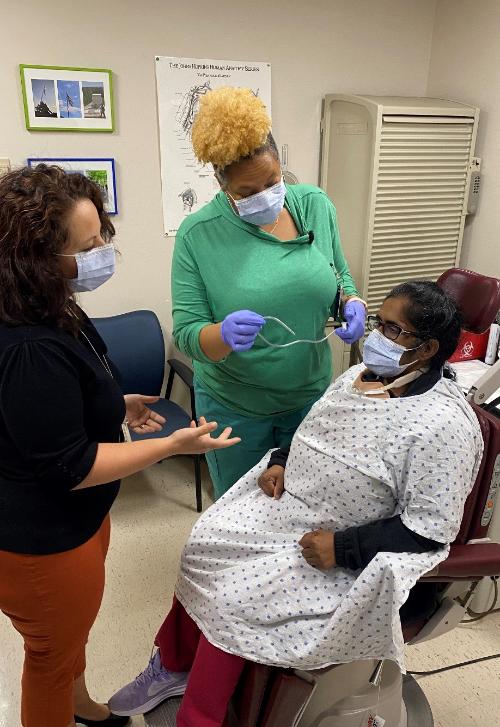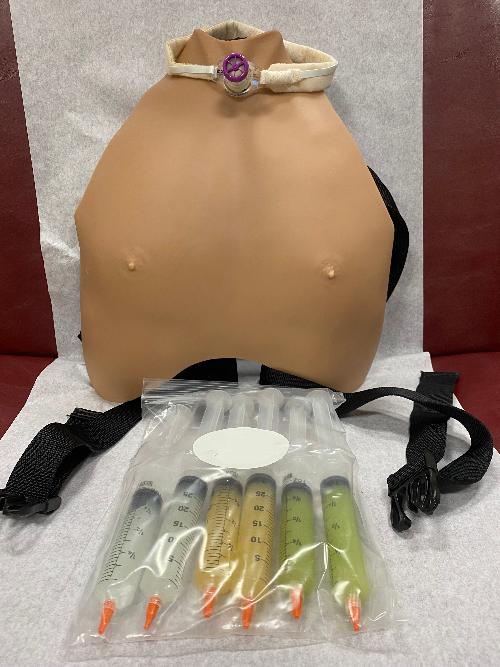VHA SimLEARN
Durham staff use Simulation to Improve Care For Tracheostomy Patient


Left Photo: Left to right: Maria Colandrea, NP (left), instructs Kutrice Riddle, LPN, on how to properly suction a standardized tracheostomy patient. Susy Babbykutti, RN, acting portrays the standardized patient wearing the simulated tracheostomy vest. (Photo provided by Tiffany Ellis, NP)
Right Photo: Simulated tracheostomy vest Susy Babbykutti wears in photo on the left. (VA Courtesy photo)
By: Maria Colandrea, DNP, NP-C, CORLN, CCRN, FAANP, Nurse Practitioner, Durham VA Healthcare System Department of Otolaryngology
Management of tracheostomy care is inconsistent among clinicians and across health care institutions. The inconsistency in tracheostomy care, as well as lack of standardization, can lead to complications that negatively impact the patient and hospital (Davis, et at., 2019; Cherney, et al., 2020). At the Durham VA Healthcare System, the Tracheostomy Committee is utilizing cutting edge wearable simulation technology as a modality to educate the nursing staff on improving tracheostomy skills and knowledge.
A simulated wearable tracheostomy vest has been an effective tool in providing nurses hands-on experience, and critical thinking scenarios allow them to roleplay situations that could be life-threatening to the patient if not quickly identified and managed. The goal of the tracheostomy simulation is for nurses to employ critical thinking skills and hands-on demonstration in the management of a potential airway obstruction and/or accidental decannulation.
The vest has Wi-Fi capability for the learner to auscultate lung sounds, which are controlled by the instructor/educator. Sputum can be purchased separately and can be instilled through the tracheostoma reservoir to allow for the real-life suctioning experience. If the nurses suction too deeply through the tracheostoma, the vest vibrates which alerts the standardized patient to cough more forcefully, simulating irritation to the carina. This allows the nurse to focus on the whole patient and be alert to verbal and non-verbal cues in the management of a potential airway emergency.
In addition to using this device for routine educational offerings on nursing units, it is also being used in a research project called, Evaluating the Educational Outcomes of Wearable Technology for the Standardized
Patient, With Mannequin-Based Simulation Education: A Translational Research Study. The purpose of this study is to compare the educational benefit of training nurses using the wearable tracheostomy vest simulator versus a high-fidelity mannequin. The study measures stress level using saliva cortisol and skill retention to evaluate the two educational modalities.
The outcomes studied include a tracheostomy care checklist to evaluate the skills of the nurse both in practice and at the bedside and salivary samples to measure cortisol and alpha amylase levels to determine the stress levels of the nurses both in practice and at the bedside. Preliminary data shows that training with the wearable simulated tracheostomy device appears to improve tracheostomy suctioning skill retention more than traditional high-fidelity simulation training.
As simulation technology continues to evolve, so will the care health care providers deliver to patients, particularly with skills and situations that are not routinely encountered. The Durham VA Healthcare System and the Durham VA Tracheostomy Committee is leading the way in this arena, and it is committed to improving tracheostomy care for Veterans using available advanced technology.
References:
Davis, K., Edgar-Zarate, C., Bonilla-Velez, J., Atkinson, T., Tulanay-Ugar, O., Agarwal, A. (2019). Using didactics and simulation to enhance comfort, knowledge and skills of nonsurgical trainees caring for patients with tracheostomy and laryngectomy. Simulation in Healthcare, 14, 384-390.Cherney, R., Pandian, V., Ninan, A., Eastman, D., Barnes, B, et al. (2020). The trach trail: A systems-based pathway to improve quality of tracheostomy care and interdisciplinary collaboration. Otolaryngology-Head and Neck Surgery, 163(2), 232-243.



















